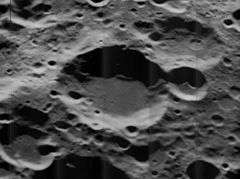Sanford (crater)
Sanford is a lunar impact crater that is located in the northern latitudes on the Moon's far side. It lies to the south-southeast of the crater Klute, and just to the west-northwest of Teisserenc. To the southwest lies Joule.
 Oblique Lunar Orbiter 5 image | |
| Coordinates | 32.6°N 138.9°W |
|---|---|
| Diameter | 55 km |
| Depth | Unknown |
| Colongitude | 140° at sunrise |
| Eponym | Roscoe F. Sanford |
This is a circular crater formation with a worn outer rim. A pair of small craterlets lies along the eastern rim, and the satellite crater Sanford C is attached to the outer edge along the north-northwest. Attached to the southern exterior is what may be the remains of a larger, unnamed crater that is now considerably eroded.
Satellite craters
By convention these features are identified on lunar maps by placing the letter on the side of the crater midpoint that is closest to Sanford.
| Sanford | Latitude | Longitude | Diameter |
|---|---|---|---|
| C | 34.1° N | 137.0° W | 18 km |
| T | 32.7° N | 143.3° W | 43 km |
| W | 33.7° N | 140.2° W | 38 km |
| Y | 33.7° N | 139.2° W | 22 km |
gollark: AMD did stealthily make the stock cooler on some of their CPUs slightly worse recently, I remember, but it should still work.
gollark: They would probably be better off upgrading the CPU to a 3600 or something and using the stock cooler.
gollark: Technically, you could use a laser as a really slow and inefficient propulsion system in space, since light has momentum or something.
gollark: > The idea was to mount a system of nuclear bombs in space where these bombs would each power approximately 50 lasers. Upon detonation these lasers would fire and theoretically destroy several dozen incoming nuclear missiles at once.
gollark: The Wikipedia page.
References
- Andersson, L. E.; Whitaker, E. A. (1982). NASA Catalogue of Lunar Nomenclature. NASA RP-1097.CS1 maint: ref=harv (link)
- Blue, Jennifer (July 25, 2007). "Gazetteer of Planetary Nomenclature". USGS. Retrieved 2007-08-05.CS1 maint: ref=harv (link)
- Bussey, B.; Spudis, P. (2004). The Clementine Atlas of the Moon. New York: Cambridge University Press. ISBN 978-0-521-81528-4.CS1 maint: ref=harv (link)
- Cocks, Elijah E.; Cocks, Josiah C. (1995). Who's Who on the Moon: A Biographical Dictionary of Lunar Nomenclature. Tudor Publishers. ISBN 978-0-936389-27-1.CS1 maint: ref=harv (link)
- McDowell, Jonathan (July 15, 2007). "Lunar Nomenclature". Jonathan's Space Report. Retrieved 2007-10-24.CS1 maint: ref=harv (link)
- Menzel, D. H.; Minnaert, M.; Levin, B.; Dollfus, A.; Bell, B. (1971). "Report on Lunar Nomenclature by the Working Group of Commission 17 of the IAU". Space Science Reviews. 12 (2): 136–186. Bibcode:1971SSRv...12..136M. doi:10.1007/BF00171763.CS1 maint: ref=harv (link)
- Moore, Patrick (2001). On the Moon. Sterling Publishing Co. ISBN 978-0-304-35469-6.CS1 maint: ref=harv (link)
- Price, Fred W. (1988). The Moon Observer's Handbook. Cambridge University Press. ISBN 978-0-521-33500-3.CS1 maint: ref=harv (link)
- Rükl, Antonín (1990). Atlas of the Moon. Kalmbach Books. ISBN 978-0-913135-17-4.CS1 maint: ref=harv (link)
- Webb, Rev. T. W. (1962). Celestial Objects for Common Telescopes (6th revised ed.). Dover. ISBN 978-0-486-20917-3.CS1 maint: ref=harv (link)
- Whitaker, Ewen A. (1999). Mapping and Naming the Moon. Cambridge University Press. ISBN 978-0-521-62248-6.CS1 maint: ref=harv (link)
- Wlasuk, Peter T. (2000). Observing the Moon. Springer. ISBN 978-1-85233-193-1.CS1 maint: ref=harv (link)
This article is issued from Wikipedia. The text is licensed under Creative Commons - Attribution - Sharealike. Additional terms may apply for the media files.